If you use articles as one of your main traffic generation tactics, then you may be making a big mistake.
No, I’m not going to argue that articles are a bad tactic and that you need to use a “secret” traffic generation technique that only I know about.
In fact, articles are a great way to create brand awareness, generate traffic, and build a long-lasting connection with your target audience. But if left on their own, articles won’t transform your audience into a potential revenue source.
To do so, the articles your company creates must be persuasive—they need to make your audience trust your brand, its capabilities, and the opportunities that it can bring to their lives.
With that in mind, here are five ways to write more persuasive articles:
1. Create case studies
Within the mind of every reader, there’s a question that rises whenever they consume one of your articles. That question is: "Why should I believe them?"
Every article you create that has any type of connection to your company’s offerings will raise that question. Decades of sales-focused marketing communication messages have made consumers distrust whatever it is that they’re being told about a brand.
"If this looks like marketing, it can’t be true," they say.
There’s not much you can do to undo such a mentality, but case studies can help change their perception of the credibility of your articles.
A case study testifies the use that a customer has gotten from one of your products or services. It shows proof that whatever your brand's value proposition is, your company can deliver it.
One of the core promises Keap makes to its target audience is its capability to "supercharge your sales and marketing." But as it says in its case studies page, "don’t take it from us—hear directly from small business owners who have found success using our technology, tools, and services."
On this page, Keap shows dozens of case studies of customers who have achieved this exact result in their businesses. Even though "supercharge" is ambiguous in nature, Keap customers attest that its software does increase sales.

Although stating that your customers are the best marketing may be a bit hyperbolic, it's true that showing evidence of their success with your company’s offerings can transform the credibility and persuasiveness of your content.
The best part is that creating a case study is not as hard as building other types of articles—like tutorials—because those customers that are happy with your company will gladly discuss your solution.
2. Use statistics
The job of a writer may seem easy at first glance: all you have to do is come up with ideas and put them together in an article. A professional writer knows this summation is false, but if you're doing the work of a writer because your boss told you so, you may not be aware that you must back your ideas with data.
A statistic allows you to add confidence to a statement because someone of authority says so. In this case, statistics refers to any type of data taken from a report, a study, or a survey. As long as the report, study or survey was statistically significant—which means the data used was proven to be caused by a known variable and not by mere chance—you can be sure it’s more authoritative than your own opinion.
Whenever possible, use some type of statistic as the basis of your ideas. Just like case studies add proof to your brand communications as a whole, statistics add proof to your articles specifically.
Non-fiction writers, especially those who make a living as content marketers, use statistics in their content.
In this article about share-worthy content, Bill Acholla states that leveraging "an influencer who engages with 3,000 people can be more helpful than a person with 10,000 followers with zero engagement."
A strong statement, indeed. But to show that this idea is actually true, he references a study done by a top software company in the influencer marketing industry.
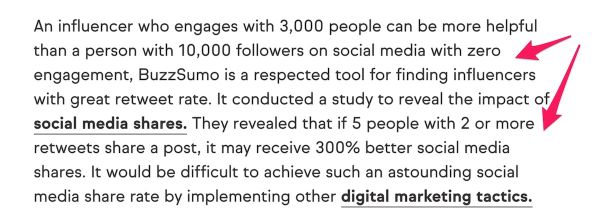
The original statement and the statistic mentioned may not seem to be entirely related, but at a closer look, it can be said that the latter validates the former.
Whenever you make a strong statement, such as the one above, you should always look for a statistic to back it up. Use a search query that mixes your topic with the word "stats" or "statistics" to find potential sources of references.
For example, if I was writing an article on CRM, I could use the following search query:

In this case, the topic is quite broad and would require some changes to find statistics that best fit my topic. Nonetheless, it shows that doing a few searches in Google will reap enough data from which to base your ideas.
3. Show examples
An article is filled with abstractions that can distract the reader from the points you'r trying to make. This article is the perfect example: I write about "persuasiveness" and "helping the reader," ideas that if left on their own, would make it hard for you to read it. I may think these ideas are obvious, but they're probably not for you, my dear readers.
Examples help you take an abstraction and bring it into reality. They add context and clarity to your ideas. Whenever possible, you should show examples of the ideas you present.
If you're writing a tutorial with a step-by-step plan, show them with images, GIFs, or videos. If you're writing about an idea, like in this article, add images that represent them in real life.
In an article I wrote on grammar mistakes, I discuss misplacing commas between nouns and verbs and other technical terms. Adding examples that showed the way these misplacements looked in a piece of text would have been a great help for my readers—and so I did. But I took my examples even further and added an image that represents these mistakes clearly:
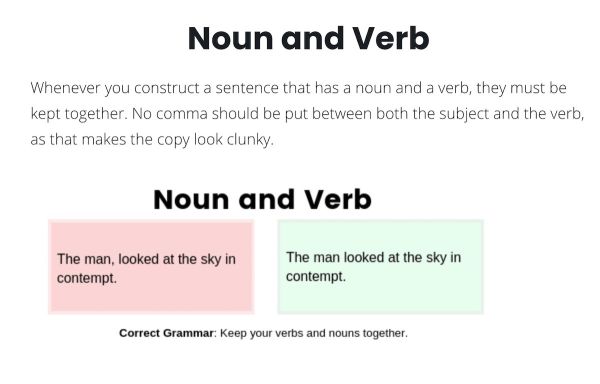
In this article that you're reading, I added screenshots with arrows that highlight some of my ideas. These types of images are like evidence that proves some of my points. While it may look silly, it’s more helpful than you think, especially when you forget that your readers don’t know as much as you do.
4. Put yourself in your customer’s shoes
When I was younger, I thought that the job of a marketer was similar to the one presented in the TV series Mad Men. It involved a group of (mostly) men coming up with ideas to sell a product or service and pitching those to their clients. The customers were left as a by-product of the ideas.
This perception of the customer as a secondary element of a brand communication strategy may have changed radically in the last few decades, but it hasn’t disappeared entirely.
Digital marketers have adopted a similar attitude toward readers as the Mad Men-era people. They put keywords or topic ideas first, and the needs of their readers second. I know about this because I’ve made this mistake.
The only way to solve this problem is to start your content creation process with your reader's problems, pains, and needs; your offers are secondary.
Unlike advertisements, an article has to educate the reader. It needs to bring something to their lives that they need. And to do that, you must uncover your reader’s profile through research, some of which has been covered before in these articles:
Based on your research, the topics of your articles should be able to show your readers that you're aware of their problems and needs. The premise behind your articles should connect these problems with the solutions you propose (which, ideally, should also relate to your offers, but that’s something we’ll leave for the next point).
For example, Keap’s premise is that through the use of marketing automation, a business owner can increase sales with less work. In each of the five categories in its blog, the company writes about how you can bring its original premise into reality.
If you take a look at the sales category—which focuses mostly on CRMs and closing deals—you'll see that all of the topics educate you on this topic without focusing on the ultimate solution proposed, which is to see a demo and subscribe to a paid plan.

Other brands in the software space do likewise, like SurveyMonkey:
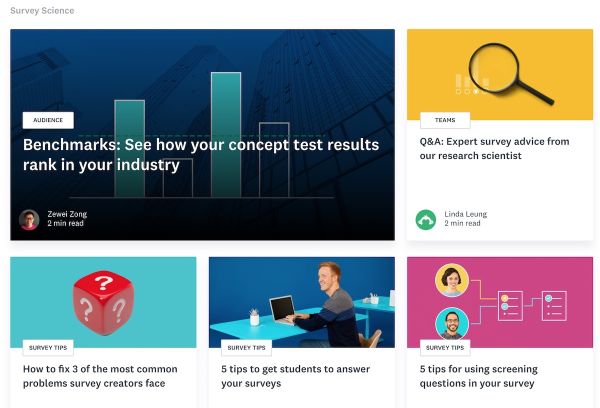
One article will hardly close a reader. But dozens of them should create an image that your brand will help them. If your articles are useful, the logic goes, so should your main offer.
5. Lead them down the funnel
In an ideal world, you shouldn’t use your articles to convince your readers to use your paid solution. Articles have a broader intent that’s not sales-focused unlike, let’s say, webinars.
But we don’t live in an ideal world, and so your articles should somehow lead your readers to consider other content pieces that gear toward your offers.
Your content should lead to some type of capture form that lets you extend your communication to other channels, like email or a phone call. For example, in this article on holiday marketing strategy, Common Thread asks the reader to "get a copy of the Holiday Marketing E-Commerce Strategy Bundle" in exchange for an email.
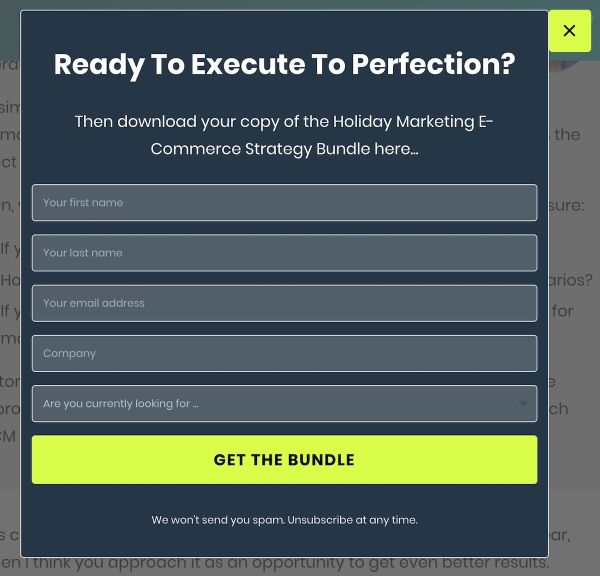
To guide this communication marketers have developed the idea of a sales funnel, which puts articles at the top, ebooks and email newsletters at the middle, and demos at the bottom.
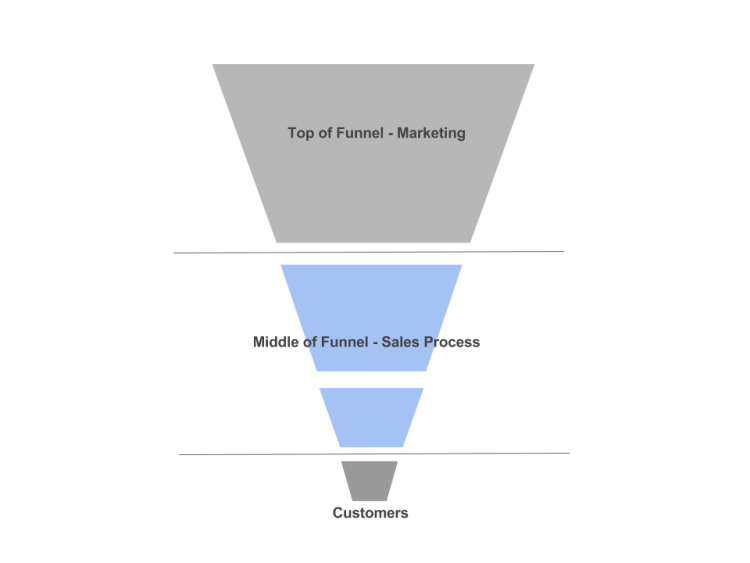
A good way to think about your company’s funnel is to break down what your ideal customer needs to know to make a purchase and then start from the top. Your articles should only focus on educating and attracting readers. Then in each step, think about how you can help them further and answer their questions.
In the case of Keap, that’s subscribing to the newsletter and seeing a demo, first at the top right of the page:

And then on the bottom left.

Your emails and other more advanced content types—like the demos shown in the examples above—should lead to more content that has a greater focus on sales.
Start to write persuasive articles
Writing persuasive articles requires a shift in mindset, from one in which you write based on your ideas and needs to one in which the reader is put first.
By using case studies and statistics, you will give your articles a veil of authority. By visualizing your ideas with examples, you will make your content easier to understand. It can be as simple as providing a list of industry stats for your audience.
By writing about the reader's problems and not your solutions, you will create a long-lasting trust. And if you can tie your content back to your offer through other means, like an email subscription, you will close the loop, from one where your readers get educated by your content to one where they become customers.
About the author
Ivan Kreimer is a freelance content marketer who creates educational content for SaaS businesses like Leadfeeder and Campaign Monitor. He likes to help people become freelance writers. Besides writing for smart people who read sites like Keap, he has also written for sites like Entrepreneur, MarketingProfs, Shopify, and others.
Before you go ...

SEE HOW YOU RANK: Take Keap's Lifecycle Automation Self Assessment and compare your business against the industry’s top performers with our proven formula and instantly reveal the strengths and gaps of your business.


